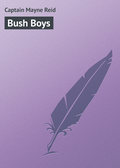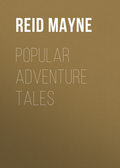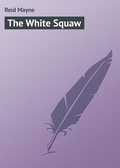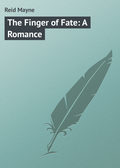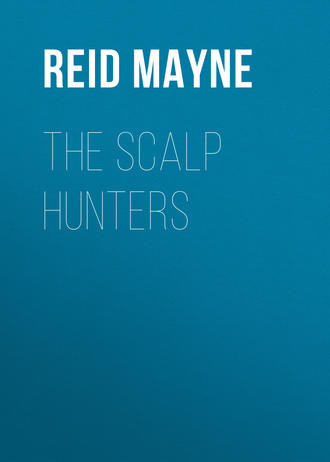
Майн Рид
The Scalp Hunters
Chapter Thirty Five.
The Mountain of Gold
After so fatiguing a march, it was necessary to make a longer halt than usual. We stayed by the arroyo all that day and the following night. But the hunters longed to drink from the Prieto itself; and the next morning we drew our pickets, and rode in the direction of that river. By noon we were upon its banks.
A singular stream it was, running through a region of bleak, barren, and desolate mountains. Through these the stream had forged its way by numerous cañons, and rushed along a channel at most places inaccessible. It was a black and gloomy river. Where were its sands of gold?
After riding for some distance along its banks, we halted at a point where its bed could be reached. The hunters, disregarding all else, clambered eagerly over the steep bluffs, and descended to the water. They hardly stayed to drink. They crawled through narrow interstices, between detached masses of rock that had fallen from above. They lifted the mud in their hands, and washed it in their cups; they hammered the quartz rock with their tomahawks, and pounded it between great stones. Not a particle of the precious metal could be found. They must either have struck the river too high up, or else the El Dorado lay still farther to the north.
Wet, weary, angry, uttering oaths and expressions of disappointment, they obeyed the signal to march forward.
We rode up the stream, halting for the night at another place where the water was accessible to our animals.
Here the hunters again searched for gold, and again found it not. Mutinous murmurs were now spoken aloud. “The gold country lay below them; they had no doubt of it. The chief took them by the San Carlos on purpose to disappoint them. He knew this would prevent delay. He cared not for them. His own ends were all he wanted to accomplish. They might go back as poor as they had come, for aught he cared. They would never have so good a chance again.”
Such were their mutterings, embellished with many an oath.
Seguin either heard not or did not heed them. He was one of those characters who can patiently bear until a proper cue for action may offer itself. He was fiery by nature, like all Creoles; but time and trials had tempered him to that calmness and coolness that befitted the leader of such a band. When roused to action, he became what is styled in western phraseology a “dangerous man”; and the scalp-hunters knew it. He heeded not their murmurings.
Long before daybreak, we were once more in our saddles, and moving onward, still up the Prieto. We had observed fires at a distance during the night, and we knew that they were at the villages of the “Club” Apache. We wished to pass their country without being seen; and it was our intention, when daylight appeared, to “cacher” among the rocks until the following night.
As dawn advanced, we halted in a concealed ravine, whilst several of us climbed the hill to reconnoitre. We could see the smoke rising over the distant villages; but we had passed them in the darkness, and instead of remaining in caché, we continued on through a wide plain covered with sage and cactus plants. Mountains towered up on every side of us as we advanced. They rose directly from the plains, exhibiting the fantastic shapes which characterise them in those regions. Their stupendous precipices overlooked the bleak, barren tables frowning upon them in sublime silence. The plains themselves ran into the very bases of these, cliffs. Water had surely washed them. These plateaux had once been the bed of an ancient ocean. I remembered Seguin’s theory of the inland seas.
Shortly after sunrise, the trail we were following led us to an Indian crossing. Here we forded the stream with the intention of leaving it and heading eastward.
We halted our horses in the water, permitting them to drink freely. Some of the hunters, moving ahead of the rest, had climbed the high banks. We were attracted by their unusual exclamations. On looking upward, we perceived several of them standing on the top of a hill, and pointing to the north in an earnest and excited manner. Could it be Indians?
“What is it?” shouted Seguin, as we pushed forward.
“A gold mountain! a gold mountain!” was the reply.
We spurred our horses hurriedly up the hill. On reaching its top, a strange sight met our gaze. Away to the north, and as far as the eye could see, an object glistened in the sun. It was a mountain, and along its sides, from base to summit, the rocks glittered with the bright semblance of gold! A thousand jets danced in the sunbeams, dazzling the eye as it looked upon them. Was it a mountain of gold?
The men were in a frenzy of delight. This was the mountain so often discussed over the bivouac fires. Who of them had not heard of it, whether credulous or not? It was no fable, then. There it was before them, in all its burning splendour.
I turned to look at Seguin. His brow was bent. There was the expression of anxiety on his countenance. He understood the illusion; so did the Maricopa; so did Reichter. I knew it too. At a glance I had recognised the sparkling scales of the selenite.
Seguin saw that there was a difficulty before us. This dazzling hallucination lay far out of our course; but it was evident that neither commands nor persuasion would be heeded now. The men were resolved upon reaching it. Some of them had already turned their horses’ heads and were moving in that direction.
Seguin ordered them back. A stormy altercation ensued; in short, a mutiny.
In vain Seguin urged the necessity of our hastening forward to the town. In vain he represented the danger we were in of being overtaken by Dacoma’s party, who by this time were upon our trail. In vain the Coco chief, the doctor, and myself, assured our uneducated companions that what they saw was but the glancing surface of a worthless rock. The men were obstinate. The sight, operating upon long-cherished hopes, had intoxicated them. They had lost all reason. They were mad.
“On, then!” cried Seguin, making a desperate effort to restrain his passion. “On, madmen, and satisfy yourselves – our lives may answer for your folly!” and, so saying, he turned his horse, and headed him for the shining beacon.
The men rode after, uttering loud and joyful acclamations.
At the end of a long day’s ride we reached the base of the mountain. The hunters leaped from their horses, and clambered up to the glittering rocks. They reached them. They broke them with their tomahawks and pistol-butts, and cleft them with their knives. They tore off the plates of mica and glassy selenite. They flung them at their feet, abashed and mortified; and, one after another, came back to the plain with looks of disappointment and chagrin. Not one of them said a word, as they climbed into their saddles, and rode sullenly after the chief.
We had lost a day by this bootless journey; but our consolation lay in the belief that our Indian pursuers, following upon our trail, would make the same détour.
Our course now lay to the south-west; but finding a spring not far from the foot of the mountain, we remained by it for the night.
After another day’s march in a south-easterly course, Rube recognised the profiles of the mountains. We were nearing the great town of the Navajoes.
That night we encamped on a running water, a branch of the Prieto that headed to the eastward. A vast chasm between two cliffs marked the course of the stream above us. The guide pointed into the gap, as we rode forward to our halting-place.
“What is it, Rube?” inquired Seguin.
“’Ee see that gully ahead o’ us?”
“Yes; what of it?”
“The town’s thur.”
Chapter Thirty Six.
Navajoa
It was near evening of the next day when we arrived at the foot of the sierra, at the debouchure of the cañon. We could not follow the stream any farther, as there was no path by the channel. It would be necessary to pass over the ridge that formed the southern jaw of the chasm. There was a plain trail among scrubby pines; and, following our guide, we commenced riding up the mountain.
After ascending for an hour or so, by a fearful road along the very brink of the precipice, we climbed the crest of the ridge, and looked eastward. We had reached the goal of our journey. The town of the Navajoes was before us.
“Voilà!”
“Mira el pueblo!”
“Thar’s the town!”
“Hurrah!” were the exclamations that broke from the hunters.
“Oh, God! at last it is!” muttered Seguin, with a singular expression of countenance. “Oh, God be praised! Halt, comrades! halt!”
Our reins were tightened, and we sat on our weary horses looking over the plain. A magnificent panorama, magnificent under any circumstances, lay before us; but its interest was heightened by the peculiar circumstances under which we viewed it.
We are at the western extremity of an oblong valley, looking up it lengthwise. It is not a valley, though so called in the language of Spanish America, but a plain walled in on all sides by mountains. It is elliptical in form, the diameter of its foci being ten or twelve miles in length. Its shortest diameter is five or six miles. It has the surface of a green meadow, and its perfect level is unbroken by brake, bush, or hillock. It looks like some quiet lake transformed into an emerald.
It is bisected by a line of silvery brightness that curves gracefully through its whole extent, marking the windings of a crystal stream.
But the mountains! What wild-looking mountains, particularly those on the north side of the valley! They are granite upheaved. Nature must have warred at the birth of these; the very sight of them suggests the throes of a troubled planet. Huge rocks hang over, only half resting upon fearful precipices; vast boulders that seem as though the touch of a feather would cause them to topple down. Grim chasms open into deep, dark defiles, that lie silent, and solemn, and frowning. Here and there, stunted trees, the cedar and pinon, hang horizontally out, clinging along the cliffs. The unsightly limbs of the cactus, and the gloomy foliage of the creosote bush, grow together in seams of the rocks, heightening their character of ruggedness and gloom. Such is the southern barrier of the valley.
Look upon the northern sierra! Here is a contrast, a new geology. Not a rock of granite meets the eye; but there are others piled as high, and glistening with the whiteness of snow. These are mountains of the milky quartz. They exhibit a variety of peaks, naked and shining; crags that hang over deep, treeless ravines, and needle-shaped summits aspiring to the sky. They too have their vegetation, a vegetation that suggests ideas of the desert and desolation.
The two sierras appear to converge at the eastern end of the valley. We are upon a transverse ridge that shuts it in upon the west, and from this point we view the picture.
Where the valley ends eastwardly, we perceive a dark background lying up against the mountains. We know it is a pine-forest, but we are at too great a distance to distinguish the trees. Out of this forest the stream appears to issue; and upon its banks, near the border of the woods, we perceive a collection of strange pyramidal structures. They are houses. It is the town of Navajoa! Our eyes were directed upon it with eager gaze. We could trace the outlines of the houses, though they stood nearly ten miles distant. They suggested images of a strange architecture. There were some standing apart from the rest, with terraced roofs, and we could see there were banners waving over them. One, larger than the rest, presented the appearance of a temple. It was out on the open plain, and by the glass we could detect numerous forms clustered upon its top – the forms of human beings. There were others upon the roofs and parapets of the smaller houses; and many more moving upon the plain nearer us, driving before them flocks of animals, mules, and mustangs. Some were down upon the banks of the river, and others we could see plunging about in the water.
Several droves of horses, whose mottled flanks showed their breed, were quietly browsing on the open prairie. Flocks of wild swans, geese, and gruyas winged their way up and down the meandering current of the stream.
The sun was setting. The mountains were tinged with an amber-coloured light; and the quartzose crystals sparkled on the peaks of the southern sierra.
It was a scene of silent beauty. How long, thought I, ere its silence would be broken by the sounds of ravage and ruin!
We remained for some time gazing up the valley, without anyone uttering his thoughts. It was the silence that precedes resolve. In the minds of my companions there were varied emotions at play, varied in kind as they differed in intensity.
Some were holy. Men sat straining their eyes over the long reach of meadow, thinking, or fancying, that in the distance they might distinguish a loved object – a wife, a sister, a daughter, or perhaps the object of a still dearer and deeper affection. No; the last could not be. None could have been more deeply affected than he who was seeking for his child. A father’s love was the strongest passion there.
Alas! there were other emotions in the bosoms of those around me, passions dark and sinful. Fierce looks were bent upon the town. Some of these betokened fierce feelings of revenge; others indicated the desire of plunder; and others still spoke, fiend-like, of murder! There had been mutterings of this from day to day as we journeyed. Men disappointed in their golden dreams had been heard to talk about the price of scalps!
By a command from Seguin the hunters drew back among the trees, and entered into a hurried council. How was the town to be taken? We could not approach it in the open light. The inhabitants would see us before we could ride up, and make their escape to the forest beyond. This would defeat the whole purpose of our expedition.
Could not a party get round to the eastern end of the valley and prevent this? Not through the plain itself, for the mountains rested upon its surface, without either foothills or paths along their sides. In some places vast cliffs rose to the height of a thousand feet, stepping directly upon the level plain. This idea was given up.
Could we not turn the southern sierra, and come in through the forest itself? This would bring us close to the houses under cover. The guide was questioned, and answered in the affirmative. But that could only be accomplished by making a détour of nearly fifty miles. We had no time for such a journey, and the thought was abandoned.
The town, then, must be approached in the night. This was the only plan practicable; at least, the most likely to succeed. It was adopted.
It was not Seguin’s intention to make a night attack, but only to surround the buildings, keeping at some distance out, and remain in ambush till the morning. All retreat would thus be cut off, and we should make sure of taking our captives under the light of day.
The men threw themselves to the ground, and, holding their bridles, waited the going down of the sun.
Chapter Thirty Seven.
The Night Ambuscade
A short hour passes. The bright orb sinks behind us, and the quartz rock saddens into a sombre hue. The straggling rays of twilight hover but a moment over the chalky cliffs, and then vanish away. It is night.
Descending the hills in a long string, we arrive upon the plain. We turn to the left, and keep round the mountain foot. The rocks guide us.
We proceed with caution, and exchange our words only in whispers. We crawl around and among loose boulders that have fallen from above. We turn many spurs that shoot out into the plain. Occasionally we halt and hold council.
After a journey of ten or twelve miles, we find ourselves opposite the Indian town. We are not over a mile from it. We can see the fires burning on the plain, and hear the voices of those who move around them.
At this point the band is divided. A small party remains making its caché in a defile among the rocks. These guard the captive chief and the antajo of mules. The rest move forward, guided by Rube, who carries them round the edge of the forest, here and there dropping a picket of several men as he proceeds.
These parties conceal themselves at their respective stations, remain silent, and wait for the signal from the bugle, which is to be given at the hour of daybreak.
The night passes slowly and silently. The fires one by one go out, until the plain is wrapt in the gloom of a moonless midnight. Dark clouds travel over the sky, portending rain: a rare phenomenon in these regions. The swan utters its wild note, the gruya whoops over the stream, and the wolf howls upon the skirts of the sleeping village. The voice of the bull-bat wails through the air. You hear the “flap, flap” of his long wings as he dashes down among the cocuyos. You hear the hoof-stroke on the hard plain, the “crop” of the browsing steed, and the tinkling of the bit-ring, for the horses eat bridled.
At intervals, a drowsy hunter mutters through his sleep, battling in dreams with some terrible foe. Thus goes the night. These are its voices.
They cease as daybreak approaches. The wolf howls no longer; the swan and the blue crane are silent; the night-hawk has filled his ravenous maw, and perches on the mountain pine; the fire-flies disappear, chased by the colder hours; and the horses, having eaten what grew within their reach, stand in lounging attitudes, asleep.
A grey light begins to steal into the valley. It flickers along the white cliffs of the quartz mountain. It brings with it a raw, cold air that awakens the hunters.
One by one they arouse themselves. They shiver as they stand up, and carry their blankets wrapped about their shoulders. They feel weary, and look pale and haggard. The grey dawn lends a ghastly hue to their dusty beards and unwashed faces.
After a short while they coil up their trail-ropes and fasten them to the rings. They look to their flints and priming, and tighten the buckles of their belts. They draw forth from their haversacks pieces of dry tasajo, eating it raw. They stand by their horses, ready to mount. It is not yet time.
The light is gathering into the valley. The blue mist that hung over the river during the night is rising upward. We can see the town. We can trace the odd outlines of the houses. What strange structures they are!
Some of them are higher than others: one, two, four stories in height. They are each in form like a pyramid without its apex. Each upper story is smaller than that below it, the roofs of the lower ones serving as terraces for those above. They are of a whitish yellow, the colour of the clay out of which they are built. They are without windows, but doors lead into each story from the outside; and ladders stretch from terrace to terrace, leaning against the walls. On the tops of some there are poles carrying bannerets. These are the residences of the principal war-chiefs and great warriors of the nation.
We can see the temple distinctly. It is like the houses in shape, but higher and of larger dimensions. There is a tall shaft rising out of its roof, and a banner with a strange device floating at its peak.
Near the houses we see corrals filled with mules and mustangs, the live-stock of the village.
The light grows stronger. Forms appear upon the roofs and move along the terraces. They are human forms enveloped in hanging garments, robe-like and striped. We recognise the Navajo blanket, with its alternate bands of black and white.
With the glass we can see these forms more distinctly; we can tell their sex.
Their hair hangs loosely upon their shoulders, and far down their backs. Most of them are females, girls and women. There are many children, too. There are men, white-haired and old. A few other men appear, but they are not warriors. The warriors are absent.
They come down the ladders, descending from terrace to terrace. They go out upon the plain, and rekindle the fires. Some carry earthen vessels, ollas, upon their heads, and pass down to the river. They go in for water. These are nearly naked. We can see their brown bodies and uncovered breasts. They are slaves.
See! the old men are climbing to the top of the temple. They are followed by women and children, some in white, others in bright-coloured costumes. These are girls and young lads, the children of the chiefs.
Over a hundred have climbed up. They have reached the highest root. There is an altar near the staff. A smoke rolls up – a blaze: they have kindled a fire upon the altar.
Listen! the chant of voices, and the beat of an Indian drum!
The sounds cease, and they all stand motionless and apparently silent, facing to the east.
“What does it mean?”
“They are waiting for the sun to appear. These people worship him.”
The hunters, interested and curious, strain their eyes, watching the ceremony.
The topmost pinnacle of the quartz mountain is on fire. It is the first flash of the sun!
The peak is yellowing downward. Other points catch the brilliant beams. They have struck the faces of the devotees. See! there are white faces! One – two – many white faces, both of women and girls.
“Oh, God! grant that it may be!” cries Seguin, hurriedly putting up the glass, and raising the bugle to his lips.
A few wild notes peal over the valley. The horsemen hear the signal. They debouche from the woods and the defiles of the mountains. They gallop over the plain, deploying as they go.
In a few minutes we have formed the arc of a circle, concave to the town. Our horses’ heads are turned inwards, and we ride forward, closing upon the walls.
We have left the atajo in the defile; the captive chief, too, guarded by a few of the men. The notes of the bugle have summoned the attention of the inhabitants. They stand for a while in amazement, and without motion. They behold the deploying of the line. They see the horsemen ride inward.
Could it be a mock surprise of some friendly tribe? No. That strange voice, the bugle, is new to Indian ears; yet some of them have heard it before. They know it to be the war-trumpet of the pale-faces!
For awhile their consternation hinders them from action. They stand looking on until we are near. Then they behold pale-faces, strange armour, and horses singularly caparisoned. It is the white enemy!
They run from point to point, from street to street. Those who carry water dash down their ollas, and rush screaming to the houses. They climb to the roofs, drawing the ladders after them. Shouts are exchanged, and exclamations uttered in the voices of men, women, and children. Terror is on every face; terror displays itself in every movement.
Meanwhile our line has approached, until we are within two hundred yards of the walls. We halt for a moment. Twenty men are left as an outer guard. The rest of us, thrown into a body, ride forward, following our leader.



